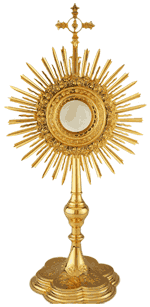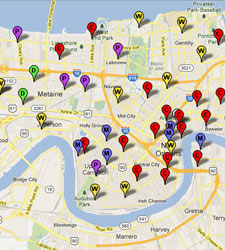Many younger Catholics don’t remember when the Holy Sacrifice of the Mass was celebrated entirely in Latin. Some older ones remember those days, either fondly or frustratingly! Because the issue of the “Latin Mass” seems to be in the secular news from time to time, I thought I would discuss it briefly here in our bulletin. I want to focus on three things: (1) the “language” of the Mass; (2) the changes in the Mass since the Second Vatican Council; and (3) the current state of the “Latin Mass.”
First of all, let’s discuss “language.” Jesus Christ and his followers probably spoke a version of the Aramaic language. But they all probably had some working knowledge of both Greek and Latin because they lived in one of the world’s crossroads, where merchants and soldiers who spoke those languages would visit. However, when the New Testament began to be put down in written form, it was done primarily in Greek. The “official” language of the New Testament is still Greek ”” although some Aramaic and Hebrew remain. But as the Church spread into the “Roman Empire” it had to adapt to a new language, since everyone didn’t speak Greek. And that’s where Latin came in. Although individual books of the Bible had been translated into Latin, it was the great St. Jerome who completely translated the entire Bible into English. This Bible was called the “Vulgate” Bible because it was the versio vuigata, which meant “common translation.” It was “common” since Latin was the language that most people in the Roman Empire were speaking at the time. Although the Mass was probably celebrated in Greek in the earliest centuries ”” since the words of Jesus in the Scripture were written in Greek ”” Latin eventually began to be the language of the Church in the 4th Century. One particular advantage of this ”˜standardization” was that the Mass and the Scriptures were basically the same for everyone. Anywhere you went to hear the Scriptures being preached (remember the first printing press wasn’t until 1455!) or the Mass being sung, it was in Latin. In fact, the core parts of Eucharistic Prayer I (also called the Roman Canon) was completed by the end of the 4th century. The Pope who had probably the most profound influence on the Mass was Pope Gregory the Great (590-604). During his reign, the readings for the Mass were organized, the parts of the Mass were standardized and beautiful music ”” “Gregorian Chant” ”” became a central part of the Mass. In fact, as one advances from the time of Pope Gregory the Great, the changes for the next 1000 years are very minor indeed. But even with those minor changes, one element remained: the Mass was in Latin.
The first real attacks on the Mass came during the Protestant Reformation. At that time, many of the core teachings of the Church were discarded, and Sunday worship changed to reflect the new beliefs. Many of the reformers didn’t believe in the Real Presence of Christ in the Eucharist, and they disregarded the idea of the Mass as a “sacrifice.” Instead, Sunday worship began to focus simply on the word of God, and the Eucharistic Sacrifice turned into a communal meal. In response to these changes, the Church convened the Council of Trent in 1545. The Council reaffirmed all of the teachings of the Church, and enacted laws to prohibit violations of Church law. Further, at that time, the Church restored the Mass “according to the custom and rite of the holy Fathers,” and enacted the Missal of Pope St. Pius V, officially called: Missale Romanum ex decreto sacrosancti Concilli Tridentini restitutum (“The Roman Missal Restored According to the Decrees of the Holy Council of Trent”). With some very minor variations, this was the Mass that was used all of the way up to the Second Vatican Council.
So what happened at Vatican II? First of all, it was never the intention of the Council that Latin be “abandoned.” The official text of the Mass is still in Latin. However, there was a desire that some of the parts of the Mass would be said in the local language of the people so that they could participate more fully. Primarily, this meant the readings and the Gospel. And this was already being done before the Council in that homilies were being given in the local language. But the Council called for a reform of the Mass because there was a wide disparity in how the Mass was being celebrated. And this really didn’t have anything to do with the Latin. But when the reformers started revising the Latin text of the Mass, they did make some substantive changes to reduce the ritual to a more simple form. Then that revised Latin text was hurriedly translated into many local languages with some big translation problems. The Novus Ordo (“New Order of the Mass”) was so different that it caused a rupture in the way that Mass had been celebrated for centuries. And this rupture was exacerbated by the fact that it was required to be used immediately ”” a sudden change that was without precedent in the history of the slow, organic development of the Mass that had preceded it. And so there were groups who protested it by continuing to say the pre-Vatican II Mass entirely in Latin.
So what is the current state of the Latin Mass? Well, it’s alive and well. Although some priests don’t know Latin very well, there are still many (including your pastor!) who occasionally celebrate Mass in Latin. And two years ago, the Holy Father officially allowed all priests to celebrate the pre-Vatican II Mass (which has no English translation) for small groups that request it. And if you go down to St. Patrick’s on Camp Street, you will still hear a beautifully sung Latin Mass ”” in both the pre-Vatican II (the “Extraordinary”) and post-Vatican II (the “Ordinary”) forms. During Lent, we’re going to bring back some of those Latin Mass parts, like the Sanctus (the “Holy holy”) and the Agnus dei (the “Lamb of God”) in chant form so that we can connect ourselves to our liturgical treasury. As I learned at Jesuit High: Latin isn’t dead; it’s immortal!




